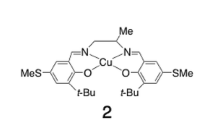Abstract
When ferric ion was added to solutions of the enzyme dextransucrase, first-order followed by second-order inactivation behavior was observed. The initial rapid activity loss was attributed to a ferric ion interacting with the thiol group of the native monomer to form a less active enzyme-ion complex; the second inactivation stage involved enzyme-ion complex aggregation and disulfide cross-link formation. In contrast, Cu2+ ion inactivation demonstrated simple first-order kinetics. As with Fe3+, Cu2+ ions can form complexes with enzyme thiol groups. However, unlike ferric ions, cupric ions can also strongly interact with the imidazole ring of histidine. Since the dextransucrase active site contains two key histidines, imidazole-cupric-ion interactions could potentially inhibit enzymatic activity. Thus, it was hypothesized that first-order Cu2+ inactivation kinetics involved the adsorption of this ion to the enzyme's activity site. The addition of a reducing agent such as dithiothreitol can inhibit the second enzyme aggregation stage by breaking disulfide cross-links but cannot restrict the initial formation of metal-enzyme complexes.
Similar content being viewed by others
References
Agarwal PK (1985) Heterogeneous denaturation of enzymes: a distributed activation energy model with nonuniform activities. Biotechnol Bioeng 27:1554–1563
Baldwin RL (1975) Intermediates in protein folding reactions and the mechanisms of protein folding. Annu Rev Biochem 44:453–475
Boyer PD (1959) Sulfhydryl and disulfide groups of enzymes. In: Boyer PD, Lardy H, Myrbäck K (eds) The enzymes, vol 1. Academic Press, New York, pp 511–588
Breslow E (1964) Comparison of cupric ion-binding sites in myoglobin derivatives and serum albumin. J Biol Chem 239:3252–3259
Caughey WS, Wallace WJ, Volpe JA, Yoshikawa S (1976) Cytochrome oxidase. In: Boyer, PD (ed) The enzymes, vol 13. Academic Press, New York, pp 299–344
Cleland WW (1964) Dithiothreitol, a new protective reagent for SH groups. Biochemistry 3:480–482
Dixon M, Webb EC (1979) Enzymes, 3rd edn. Academic Press, New York, pp 271–331
Downes JM, Whelan J, Bosnich B (1981) Biological analogues. Spectroscopic characteristics of mercapto- and disulfide-copper(II) coordination in relation to type I proteins. Inorg Chem 20:1081–1086
Ehrenberg L, Harms-Ringdahl M, Fedorcsák I, Granath F (1989) Kinetics of the copper- and iron-catalyzed oxidation of cysteine by dioxygen. Acta Chem Scand 43:177–187
Fishbean WN, Nagarajan K (1971) Urease catalysis and structure VII. Factors involved in urease polymerization and its kinetic pattern. Arch Biochem Biophys 144:700–714
Fu D, Robyt JF (1988) Essential histidine residues in dextransucrase: chemical modification by diethyl pyrocarbonate and dye photooxidation. Carbohydrate Res 183:97–109
Hamed MY, Silver J (1983) Studies of the reaction of ferric ion with glutathione and some related thiols. Part II. Complex formation in the pH range of three to seven. Inorg Chim Acta 78:1–11
Hanaki A, Kamide H (1973) Manometric study of the copper-catalyzed oxidation of cysteine. Chem Pharm Bull (Tokyo) 19:1006–1010
Kaboli H, Reilly PJ (1980) Immobilization and properties ofLeuconostoc mesenteroides dextransucrase. Biotechnol Bioeng 22:1055–1069
Kobayashi M, Matsuda K (1976) Purification and properties of the extracellular dextransucrase fromLeuconostoc mesenteroides NRRL B-1299. J Biochem (Tokyo) 79:1301–1308
Lencki RW, Arul J, Neufeld RJ, (1992a) Effect of subunit dissociation, denaturation aggregation and coagulation on enzyme inactivation kinetics. I. First-order behavior. Biotechnol Bioeng 40:1421–1426
Lencki RW, Arul J, Neufeld RJ (1992b) Effect of subunit dissociation, denaturation aggregation and coagulation on enzyme inactivation kinetics. II. Biphasic and grace period behavior. Biotechnol Bioeng 40:1427–1434
Lencki RW, Tecante A, Choplin L (1993) Effect of shear on the inactivation kinetics of the enzyme dextransucrase. Biotechnol Bioeng 42:1061–1067
Miller GL (1959) Use of dinitrosalicylic acid reagent for determination of reducing sugar. Anal Chem 31:426–428
Paul F, Auriol D, Oriol E, Monsan P (1984) Production and purification of dextransucrase fromLeuconostoc mesenteroides, NRRL B512(F). Enzyme Eng 434:267–270
Porath J, Carlsson J, Olsson I, Belfrage G (1975) Metal chelate affinity chromatography, a new approach to protein fractionation. Nature 258:598–599
Reiner JM (1969) Behaviour of enzyme systems, 2nd ed. van Nostrand Reinhold, New York, pp 293–303
Robyt JE, Walseth TE (1979) Production, purification and properties of dextransucrase fromLeuconostoc mesenteroides NRRLB-512F. Carbohydr Res 68:95–111
Sadana A, Henley JP (1987) Single-step unimolecular non-firstorder enzyme deactivation kinetics. Biotechnol Bioeng 30:717–723
Taylor JE, Yan JF, Wang J-H (1966) The iron(III)-catalyzed oxidation of cysteine by molecular oxygen in the aqueous phase. An example of a two-thirds-order reaction. J Am Chem Soc 88:1663–1667
Tirrell M, Middleman S (1975) Shear modification of enzyme kinetics. Biotechnol Bioeng 17:299–303
Tirrell M, Middleman S (1978) Shear deformation effects in enzyme catalysis. Biophys J 23:121–128
Torchinskii IM (1981) Sulfur in proteins. Pergamon Press, Oxford, pp 123–135
Author information
Authors and Affiliations
Rights and permissions
About this article
Cite this article
Lencki, R.W., Delaire, M., Tecante, A. et al. Effect of ferric and cupric ions on the inactivation rate of dextransucrase. Appl Microbiol Biotechnol 42, 263–269 (1994). https://doi.org/10.1007/BF00902727
Received:
Revised:
Accepted:
Issue Date:
DOI: https://doi.org/10.1007/BF00902727



